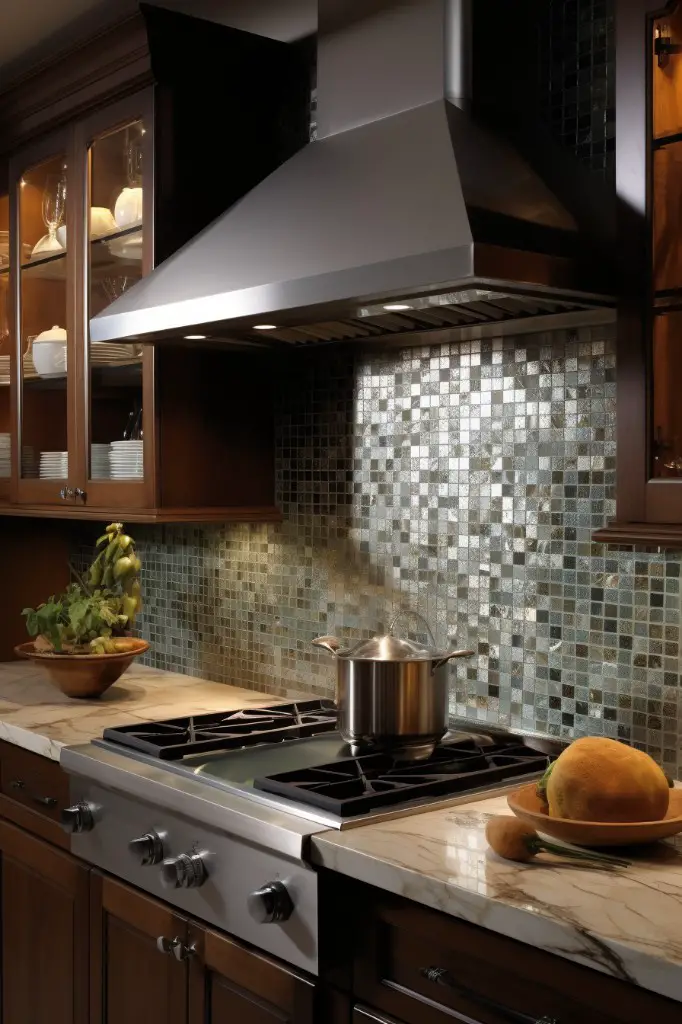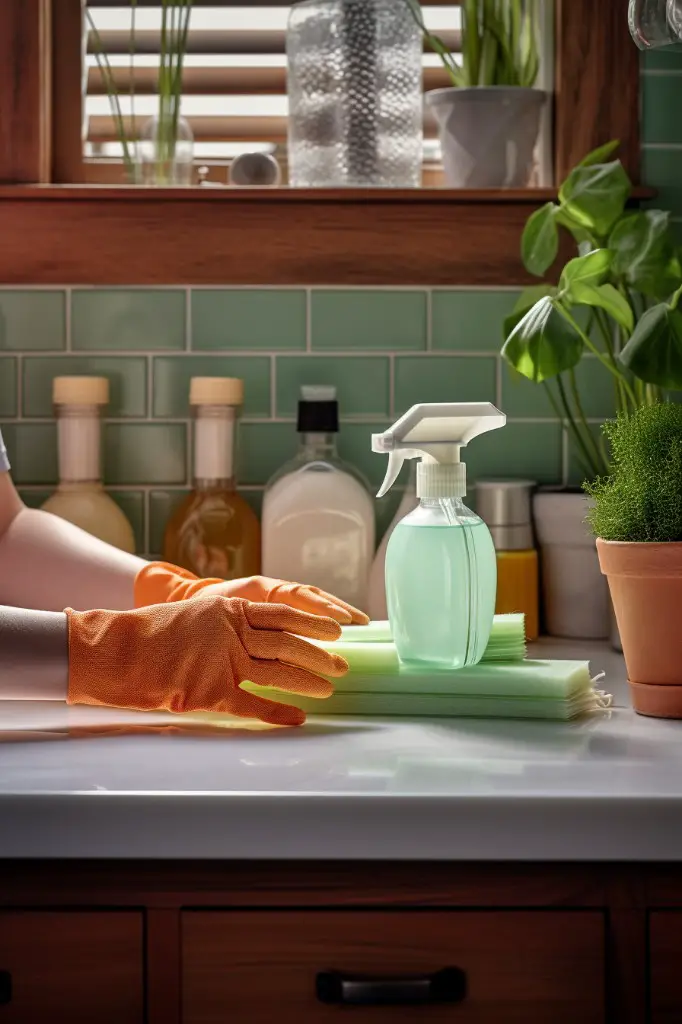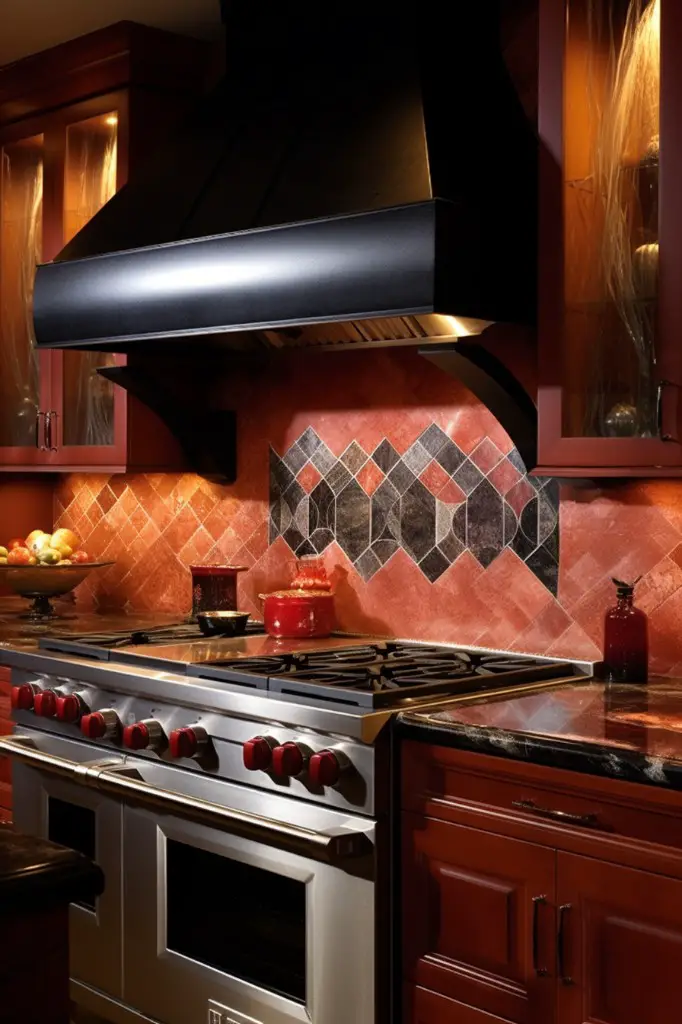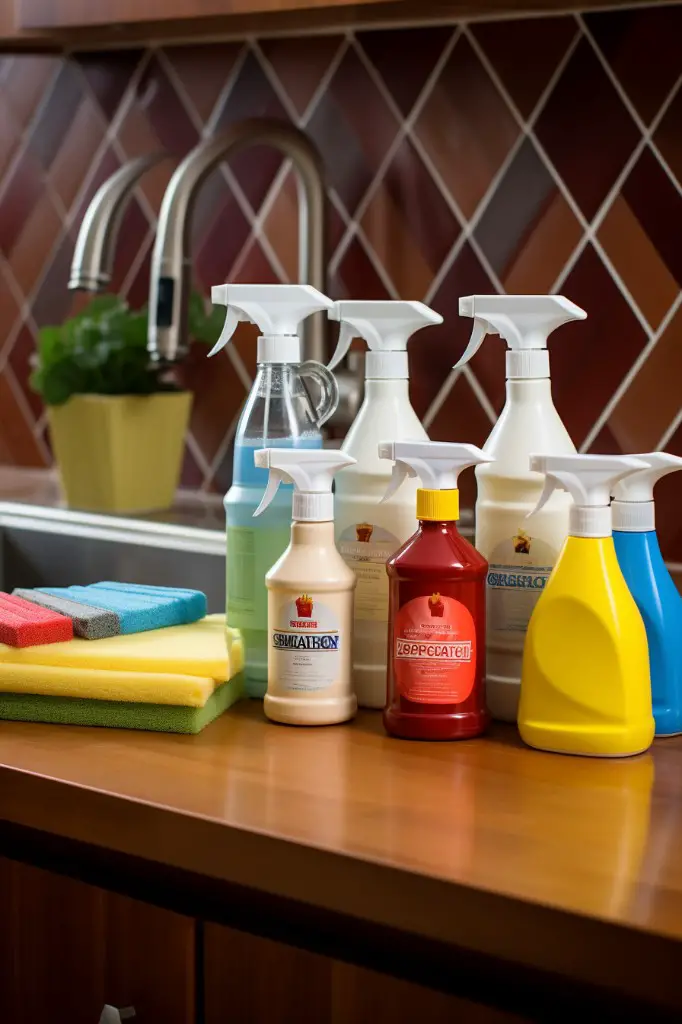Last updated on
Discover the simple steps to effectively clean your kitchen backsplash and keep it looking fresh and spotless.
The kitchen is the heart of every home, and it’s no secret that it can get messy quickly. One area that often gets overlooked during cleaning is the kitchen backsplash.
Whether you have tiles, glass, or stainless steel backsplash, it can be a real challenge to keep them clean and looking their best. But don’t worry; in this article, we’ll share some tips and tricks on how to clean your kitchen backsplash effectively without damaging it.
So roll up your sleeves and let’s get started!
What's Inside
Types of Backsplash Materials

Here are some common types of backsplash materials and how to clean them:
1. Ceramic and Porcelain Tiles: These tiles are durable, easy to clean, and come in a variety of colors and patterns.
Use a mixture of warm water with mild dish soap or vinegar solution to wipe down the surface.
2. Glass Tiles: Glass tiles add an elegant touch to any kitchen but can be tricky when it comes time for cleaning as they tend to show streaks easily.
A simple solution is using rubbing alcohol mixed with water in equal parts.
3. Stone Tiles: Stone tiles such as granite or marble require special care during cleaning because they can scratch easily if not handled properly.Use pH-neutral cleaners specifically designed for natural stone surfaces.
4. Metal Backsplash: Metal backslashes like stainless steel give off a modern look but fingerprints on metal surfaces can be quite visible.To remove smudges from metal backsplashes, use warm soapy water followed by buffing dry with microfiber cloth.
5. Beadboard: Beadboard is made up of wood planks that have grooves between them which makes it difficult to clean without damaging the surface.Avoid using harsh chemicals on beadboards; instead opt for gentle cleansers like baking soda paste or white vinegar diluted in hot water.
Preparation Steps for Cleaning

This will help make the process more efficient and prevent any damage to your backsplash material.
Firstly, remove any items that may be on or near your backsplash such as utensils, small appliances or decorative objects. This will give you a clear view of what needs cleaning and prevent anything from getting in the way during cleaning.
Next, dust off loose debris with a soft-bristled brush or microfiber cloth. You can also use a vacuum cleaner attachment for this step if there is significant build-up on your tiles.
After removing loose dirt particles from the surface of your kitchen backsplash tile, it’s time to choose an appropriate cleaner based on its type (glass tiles require different cleaners than metal ones). Make sure you have all necessary supplies like gloves and sponges before starting so that everything is within reach when needed!
Identify the Type of Backsplash Material

Different materials require different cleaning methods and solutions. Here are some common types of backsplash materials:
1. Ceramic or Porcelain Tiles: These tiles are durable and easy to clean but can be prone to staining if not sealed correctly.
2. Glass Tiles: They add a modern touch to any kitchen, but they can scratch easily if abrasive cleaners or tools are used.
3. Stone Tiles: Marble, granite, slate – these natural stones give an elegant look but need special care as they’re porous and susceptible to etching from acidic substances like vinegar or lemon juice.
4. Metal Backsplash: Stainless steel is a popular choice for its sleek appearance; however, it requires regular polishing with specific products designed for metal surfaces.
5. Beadboard Backsplash- This type of backsplash is made up of wood planks that create vertical lines on the wall surface giving off a rustic vibe in your kitchen space.
6. Brick Backsplash- Brick backslashes have become increasingly popular over time due their durability and ability withstand high temperatures without cracking.
Routine Maintenance for Kitchen Backsplash

This will help prevent the build-up of dirt and grime that can be difficult to remove later on. Here are some tips for maintaining your kitchen backsplash:
1. Wipe down the surface regularly: Use a damp cloth or sponge to wipe down the surface of your backsplash after each use.
2. Avoid harsh chemicals: Harsh chemicals can damage certain types of materials, such as natural stone or metal tiles.
3. Clean up spills immediately: If you spill something on your backsplash, clean it up right away before it has a chance to dry and become more challenging to remove.
4. Use gentle cleaning solutions: When cleaning your kitchen backsplash, use mild soap and warm water or a specialized cleaner designed specifically for the type of material used in making the backslash.
How to Deep-Clean Kitchen Backsplash Tiles
Deep-cleaning is essential for removing stubborn stains and grime that regular cleaning cannot remove. Here are some steps to follow:
1. Start by wiping down the surface with a damp cloth or sponge to remove any loose dirt or debris.
2. Apply a cleaning solution suitable for your tile material, such as vinegar and water mixture for ceramic tiles or baking soda paste for stone tiles.
3. Let the solution sit on the surface of your backsplash tile according to instructions (usually 10-15 minutes).
4. Use a soft-bristled brush or scrubber pad (avoid using abrasive materials) in circular motions over each tile until all dirt and stains are removed.
5. Rinse thoroughly with clean water, making sure there is no residue left behind from cleaning products.
6. Dry off excess moisture with a clean towel before buffing gently in circular motions using another dry cloth.
Cleaning Ceramic and Porcelain Tiles
These tiles can still get dirty over time from cooking splatters or grease buildup.
To clean ceramic or porcelain tile backsplash effectively:
- Start by wiping down the surface with warm water to remove any loose dirt or debris.
- Mix a cleaning solution of equal parts water and vinegar in a spray bottle.
- Spray the solution onto the tile surface generously.
- Let it sit for 5-10 minutes before scrubbing gently with a soft-bristled brush or sponge.
- Rinse thoroughly with warm water until all soap residue is removed.
Avoid using abrasive cleaners that can scratch your ceramic or porcelain tiles’ finish as well as steel wool pads that may leave scratches on them too.
Cleaning Glass Tiles
They can be challenging to clean without leaving streaks or scratches on the surface. To clean glass tiles effectively, start by wiping down the surface with a soft cloth or sponge dipped in warm water mixed with mild dish soap.
Avoid using abrasive cleaners that can scratch the glass surface. Instead, use vinegar diluted in water as an effective cleaning solution for removing stubborn stains and grime from your glass tile backsplash.
To prevent streaking when cleaning your glass tile backsplash, dry it off immediately after washing it down with a microfiber cloth or paper towel. This will help you achieve that sparkling finish you desire while keeping your kitchen looking its best.
Maintaining a spotless kitchen requires regular upkeep of all surfaces including your backsplash area regardless of material type used during installation.
Cleaning Stone Tiles
They require special care when it comes to cleaning. Before you start cleaning your stone tile backsplash, make sure you identify the type of stone used as different stones have different properties that affect how they should be cleaned.
For example, marble is more porous than granite and can easily stain if not properly sealed or cleaned with acidic solutions. On the other hand, slate is less porous but can still be damaged by harsh chemicals or abrasive scrubbers.
To clean your stone tile backsplash effectively without damaging it:
- Start by wiping down the surface with a soft cloth or sponge dipped in warm water.
- Avoid using vinegar-based cleaners on natural stones like marble as they can etch and dull its surface.
- Instead use pH-neutral cleaners specifically designed for natural stones.
- For tough stains like grease marks or food spills use baking soda mixed with water to form a paste then apply gently on the affected area before rinsing off thoroughly.
Cleaning Metal Tiles
Metal tiles can be tricky to clean if you don’t know what you’re doing. The first step in cleaning metal tiles is identifying the type of metal used in your backsplash.
Stainless steel is one of the most common types of metals used for kitchen backsplashes. To clean stainless steel, use warm water and mild soap or dish detergent with a soft cloth or sponge.
Avoid using abrasive cleaners that can scratch the surface.
For copper and brass tiles, mix equal parts vinegar and salt into a paste-like consistency then apply it onto your tile’s surface using an old toothbrush or soft-bristled brush gently scrubbing away any dirt buildup before rinsing off with warm water.
Aluminum requires gentle care as well since it scratches easily; therefore avoid harsh chemicals when cleaning aluminum surfaces instead opt for mild soaps mixed with lukewarm water applied on microfiber cloths wiping down until all grime has been removed from its surface area without leaving behind any residue which could cause further damage over time.
Cleaning Beadboard
It can be challenging to clean due to the grooves between each board. To clean beadboard, start by dusting off any loose dirt or debris with a soft-bristled brush or vacuum cleaner attachment.
Next, mix warm water and mild dish soap in a bucket. Dip a sponge into the solution and wring out excess water before wiping down the beadboard surface.
Use an old toothbrush to scrub any stubborn stains or grime in between the grooves.
Avoid using abrasive cleaners that can scratch or damage your beadboard finish. Also, do not use too much water as it may seep behind your boards causing them to warp over time.
Once you have finished cleaning your beadboards thoroughly rinse with fresh water then dry immediately with a microfiber cloth.
Cleaning Brick Backsplash
Cleaning brick can be tricky as it’s porous and prone to staining. To clean your brick backsplash, start by removing any loose dirt or debris with a soft-bristled brush or vacuum cleaner.
Next, mix warm water with mild dish soap in a bucket. Dip a sponge into the solution and gently scrub the bricks in circular motions until they’re clean.
Avoid using abrasive cleaners or harsh chemicals that can damage the surface of your bricks.
If you have stubborn stains on your brick backsplash, try making a paste of baking soda and water. Apply it directly onto the stain and let it sit for 10-15 minutes before scrubbing with a soft-bristled brush.
Once you’ve finished cleaning your brick backsplash, rinse thoroughly with warm water to remove any soap residue. Use an absorbent towel to dry off excess moisture from the surface of each individual brick carefully.
Grout Cleaning Techniques
Grout is porous, which means it can easily absorb dirt, grease, and other substances that can cause discoloration over time.
To clean your grout effectively, you’ll need to use a combination of techniques. First off, start by wiping down the surface with warm water and soap to remove any loose debris or dirt particles.
Then apply a mixture made up of baking soda paste (made by mixing baking soda with water) onto your toothbrush or scrub brush.
Scrub gently in circular motions along each line until you see an improvement in color. Rinse thoroughly with warm water once done scrubbing all lines on your backsplash tile area.
Finding the Best Cleaning Solution for Your Kitchen Backsplash Tile
There are many commercial cleaners available in stores, but not all of them are suitable for every type of tile. Some may contain harsh chemicals that can cause etching or fading on delicate surfaces like glass and metal.
To avoid this problem, you can make a homemade cleaning solution using natural ingredients such as vinegar and baking soda. These solutions work well on most types of tiles without causing any harm to their surface.
For ceramic and porcelain tiles, use a mild detergent mixed with warm water to clean them thoroughly. Avoid using abrasive sponges or scrubbers as they can scratch the surface.
Glass tiles require gentle care when cleaning because they’re prone to scratches and cracks if handled roughly. Use a soft cloth dipped in soapy water or white vinegar diluted with water for effective results.
Stone backsplashes need special attention since some stones like marble are porous and absorb liquids quickly leading to stains if not cleaned properly. Use pH-neutral stone cleaner specifically designed for natural stone surfaces instead of acidic cleaners which will damage its finish over time.
Homemade Cleaning Solutions
Here are some homemade cleaning solutions you can try:
1. Vinegar and Water Solution: Mix equal parts of white vinegar and water in a spray bottle.
Spray the solution on your backsplash, let it sit for a few minutes, then wipe it off with a clean cloth.
2. Baking Soda Paste: Make a paste by mixing baking soda with water until it forms a thick consistency.
Apply the paste to any stains or grime on your backsplash using an old toothbrush or sponge and scrub gently.
3. Lemon Juice Solution: Squeeze fresh lemon juice into warm water in equal parts and mix well before applying onto the surface of your kitchen backsplash tiles.
4. Olive Oil Mixture: Mix 1/4 cup olive oil with 2 tablespoons of baking soda until they form into smooth mixture .Apply this mixture onto tile surfaces using soft cloth ,then rinse thoroughly.
Stain Removal Tips
Don’t worry; there are several ways to remove them effectively without damaging the surface.
For grease and oil stains, mix baking soda with water to form a paste. Apply it directly onto the stain and let it sit for 10-15 minutes before wiping away with a damp cloth.
For stubborn food or drink stains, try using white vinegar mixed with warm water in equal parts. Soak a clean cloth in the solution and apply it directly onto the stain for about 5-10 minutes before wiping away.
If you have hard water spots or mineral buildup on your backsplash tiles, use lemon juice mixed with warm water to dissolve them gently. Apply this mixture using a soft-bristled brush or sponge then rinse thoroughly afterward.
Remember always to test any cleaning solution first on an inconspicuous area of your backsplash before applying it more broadly.
Drying and Buffing the Backsplash
This will help prevent water spots and streaks from forming on the surface. To do this, use a clean microfiber cloth or a soft towel to wipe down the backsplash thoroughly.
Start at the top of the backsplash and work your way down in small sections until you’ve covered all areas. Be sure to pay extra attention to any grout lines or crevices where dirt may have accumulated during cleaning.
After drying, take another clean microfiber cloth or towel and buff the surface gently in circular motions. This will help bring out its natural shine while removing any remaining streaks or smudges.
Remember that different types of materials require different care when drying them after cleaning; for example, metal tiles should be dried with a soft cloth immediately after washing as they can rust if left wet for too long.
Preventing Stains and Build-Up
One of the easiest ways is by wiping down the backsplash after each use. This will help remove any grease or food particles before they have a chance to stick.
Another way is by using a protective sealant on your backsplash tiles. A sealant can help repel water, oil, and other liquids from penetrating into the tile surface, making it easier for you to clean up spills quickly.
You should also avoid using harsh chemicals or abrasive cleaners on your kitchen backsplash as they can damage the surface over time. Instead, opt for gentle cleaning solutions like vinegar or baking soda mixed with warm water.
Protecting Your Backsplash From Future Stains
One of the easiest ways to do this is by applying a sealant. A sealant will create a barrier between the surface and any potential spills or splatters, making cleaning up much easier.
Before applying any sealant, make sure that your backsplash is completely clean and dry. Then follow the manufacturer’s instructions for application carefully.
Another way to protect your backsplash is by using a protective film or cover during cooking or food preparation activities that may cause splatters. These films are easy to apply and remove without leaving residue on your tiles.
When to Call a Professional Cleaner
If you have tried all the DIY methods and still cannot get rid of stubborn stains or grime, then it may be time to seek help from a professional cleaner.
Professional cleaners have access to specialized equipment and cleaning solutions that can effectively remove even the toughest stains without damaging your backsplash. They also know how to handle different types of materials and will ensure that your backsplash is cleaned thoroughly.
If you’re short on time or simply don’t want to deal with the hassle of cleaning yourself, hiring a professional cleaner could be an excellent option for you. They’ll take care of everything from start-to-finish so that you can focus on other things.
Knowing when it’s appropriate for calling in professionals will save both money and effort while ensuring optimal results.
FAQ
How do you clean grease off backsplash?
To clean grease off backsplash, wipe it down with a soft rag or paper towels using a heavy-duty degreasing cleaner, repeating if necessary, and rinse with a clean, wet rag to remove cleaning residue.
What is the best easy to clean kitchen backsplash?
The best easy-to-clean kitchen backsplash is porcelain tile due to its long-lasting, stain-resistant, and less porous properties.
How often should you clean kitchen backsplash?
You should clean the kitchen backsplash daily, especially the area directly behind the stove, to prevent grease and food stains from becoming difficult to remove.
What natural cleaning solutions can be used to remove stains from a kitchen backsplash?
Natural cleaning solutions to remove stains from a kitchen backsplash include using vinegar, baking soda, lemon juice, or a mixture of these ingredients.
How can you maintain a stainless steel backsplash in your kitchen for long-lasting shine?
To maintain a stainless steel backsplash in your kitchen for long-lasting shine, regularly clean it with a soft cloth and mild detergent, then rinse and dry thoroughly.
Are there any prevention methods to avoid build-up on your kitchen backsplash?
To prevent build-up on your kitchen backsplash, wipe it regularly with a damp cloth and use a grease-cutting cleaner to remove grime and stains.




